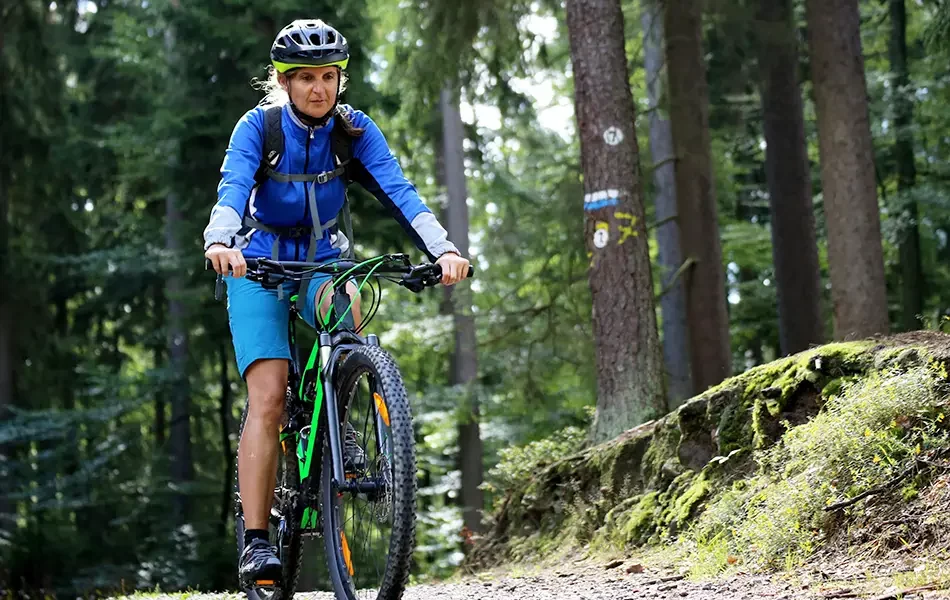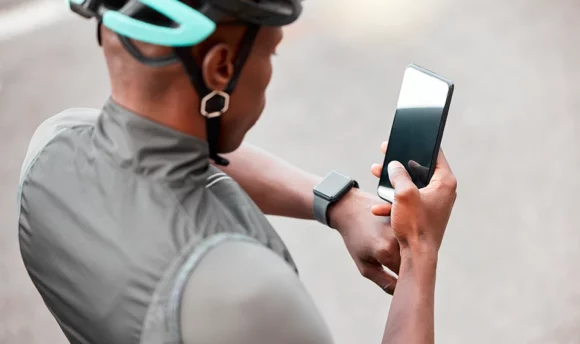What Is a Good Average Cycling Distance for Beginners? + Tips to Improve It
From your health and fitness levels to the weather and terrain, there are a range of factors affecting how far you’re able to cycle. But what is the average cycling distance for a beginner? Find out how you can improve your distance, speed, and cycling skills with 6 simple tips.

Cycling is not only an effective way to improve your strength and agility and get your heart pumping, but it is also a great way to relax and unwind. Getting outside also has several mental health benefits, so you should consider getting on a bike.
However, as with any new hobby, taking up cycling isn’t as easy as it seems – there are a number of factors to consider, including how far you should ride.
Discover the answer to that question, along with 6 handy tips to increase your distance and improve your skills with each ride.
What’s the Average Cycling Distance for Beginners? Here’s How Far You Should Go
The average recommended cycling speed for a beginner is 12 miles per hour. In terms of the time it takes to complete this distance, a sensible target to aim for is 60 minutes.
This should feel relatively easy, even if it’s your first time on a road bike. But don’t be discouraged if you struggle to reach this goal at first.
The exact distance a beginner can ride will vary from person to person, depending on a number of factors that we’ll explore in more detail.
How Far Can a Beginner Cycle?
While it’s important to gradually increase your distance when you start out, you should avoid overly long rides so you don’t risk burning out, both physically and mentally.
Here’s an idea of how far you should be able to ride, how long it will take, and how easy you’ll find it.
| Distance (miles) | Average time taken | Difficulty |
| 0–6 | 30 minutes | Very easy |
| 7–12 | 1 hour | Easy |
| 13–18 | 1 hour 30 minutes | Normal |
| 19–25 | 2 hours 20 minutes | Hard |
| 26–31 | 3 hours 15 minutes | Very hard |
| 31+ | 4 hours+ | Beginners should avoid |
What Factors Determine How Far a Beginner Should Cycle?
If you have just started cycling, your cardiovascular system will need time to adjust to this new form of exercise. You’re also still getting used to the feel of the saddle.
Some people take longer than others to find what works for them, so it is difficult to give a precise number of miles a beginner should ride.
Read on to find out what other factors can determine how far you’ll go on your first ride.
#1 Fitness level
Your health and fitness level are directly related to how far you’ll be able to cycle – the fitter you are, the further and faster you’re likely to go.
However, cycling recruits muscles within the legs that you may not have worked before, including the quadriceps, hamstrings, glutes, and calves. When there is an increase in workload, meaning that you cycle faster or further, these muscles are worked even harder.
This activity also activates the core muscles, including the abdominals, obliques, and lower back, which keep you stable and upright in the saddle.
The stronger each of these muscles is, the easier it will be for you to power through the ride. This means you’ll be able to go farther than someone whose leg and core muscles are weaker.
#2 Goal of the workout
If you’re training for a triathlon or are using cycling to change your body shape, you’re likely to cover more distance than those simply riding for fun or to improve their mental health.
Similarly, cycling can be an effective method of cross-training for runners. As well as improving your stamina and heart health, cycling can also help with recovery by flushing the legs out and helping blood move through the muscles.
So cycling for recovery means that you’ll ride at a slower speed and probably won’t go as far.
#3 Terrain
For the first few rides, those who choose a smooth, flat route will go farther than those who ride up hills and slopes.
This is because you will find it easier to build up speed on a flat surface, whereas you may find it difficult to maintain a steady pace or go far on steeper terrain.
#4 Type of surface
From roads and sidewalks to trails and mountain trails, there are a variety of surfaces you can choose to ride.
A beginner cyclist should stick to roads in their local area, as other surfaces can be rougher and more difficult to navigate. You’re also more likely to encounter rocks, tree branches, and other obstacles that could cause you problems.
Even when it comes to road cycling, roads that are older and in poorer condition will take longer to ride, which means your mileage will be lower.
#5 Weather
When it’s pouring down with rain, and you’re cold and wet, your cycling performance may suffer. Plus, if the wind is blowing in the wrong direction, the rain will blow toward you, block your vision, and make the ride slower and harder.
On a hot, sunny day, the sweltering heat will likely prevent you from riding the same distance as you would on a day with moderate temperatures. In either case, you’ll tire much faster and have a harder time maintaining your speed.
#6 Cycling gear
The lighter and more aerodynamic your gear, the faster you’ll be able to go and the more distance you’ll be able to cover.
Your average speed and distance will also depend on the type of bike you choose. Road bikes tend to weigh less than mountain or commuter bikes, so you don’t have to use as much energy to get them moving.
#7 Health and bodily sensations
Another factor that can affect the distance you can ride is your overall health and well-being. If you are recovering from any form of illness, your endurance is likely to be much lower as your body and mind build up the energy to function properly.
To avoid injury and mental burnout, it’s important to listen to your body. So, if your muscles feel particularly sore when you get on the saddle, or you’ve had a poor night’s sleep, you should perform a less intense workout. This could mean cycling slower or traveling a shorter route.
How Can You Increase the Cycling Distance?
If you’re hoping to improve your cycling skills and go further, your goal should be to increase your mileage by about 10% each week. This will allow you to ride longer distances and see more than just what your local area has to offer.
As mentioned earlier, it’s important to listen to your body, so only ride when you feel ready. Here are some tips to help you do this safely and effectively.
#1 Invest in high-quality gear
If you want to keep increasing your distance, you’ll need to invest in the right equipment to keep you comfortable in the saddle. For maximum distance, choose a high-quality, aerodynamic road bike, as these are much lighter than, say, mountain bikes.
You should also make sure that the size of the bike you choose is perfect for you. Otherwise, you may find it difficult to keep going. You’ll need to know your height and the length of your inseam, which you can then compare to the frame size of your chosen model.
We’d recommend purchasing a pair of padded cycling shorts, which will help to significantly reduce saddle-soreness, an issue that can prevent you from cycling further. You’ll also need a water bottle and holder to ensure that you stay hydrated throughout your ride.
One of the most important pieces of equipment is a helmet. As a beginner, you may find it difficult to keep your balance, which puts you at greater risk of falling off your bike and sustaining an injury. Helmets provide a 66–88% reduction in the risk of head and brain injuries.
In winter, you’re more likely to be riding in the dark, so make sure you have high-vis clothing and lights on the front and back of your bike. Otherwise, you may have to cut your ride short.
#2 Choose an easier terrain
Be sure to plan your route by choosing flat, unobstructed terrain that will allow you to cover more distance without expending more energy. Rough, rocky, or muddy trails with many turns and inclines are much harder to ride.
As your gluteal muscles become accustomed to the hard saddle, incorporate inclines into your riding as they help build endurance, which means you can ride farther.
#3 Take breaks
Planning a route in advance is also useful for making sure you include enough breaks in your ride.
This may add to the length of your ride, but stopping for a restroom, water, and a snack will help maintain your energy levels and therefore increase your average speed, which will offset the extra time.
#4 Bike with friends
It’s a good idea to ride in a team as a more experienced cyclist can take the lead, meaning they’ll limit wind resistance for a beginner cyclist.
This means that those following behind will encounter between 27–66% less drag, so they’ll require less energy to pedal and can hence cycle faster and further.
Cycling with friends also means that you’ll have your own group of cheerleaders who will keep you motivated even when the ride gets tough.
#5 Cross-train
Completing other forms of exercise is not only important for avoiding overtraining and injury, but it can also improve your stamina and ability to cycle further, therefore, boosting your cycling performance.
Try to incorporate strength training into your routine 1–2 times per week. This will help you build lean muscle mass, which will increase your power, average speed, and strength so you can go farther and faster before you fatigue.
#6 Don’t forget about nutrition
When it comes to nutrition for cyclists, you need to make sure that you’re fueling yourself properly both on and off the bike if you want to make progress.
Carbohydrates are our body’s main energy source and should provide 55–65% of a cyclist’s total caloric intake. Your carb intake should be around 30–60g per hour when you’re riding to counteract the calories burnt, which you can get through energy drinks, gels, and dried fruits.
You should also ensure that you are hitting your protein goals, as this is an important macronutrient for maintaining the muscle mass that helps to power you through your ride.
Be sure to drink plenty of water throughout the day, as you’re at risk of dehydration while on your ride.
FAQs
A beginner should find it fairly easy to ride 7–12 miles a day at a pace that allows you to hold a conversation. Aim to increase your starting distance by 10% each week.
A good speed for beginner cyclists is around 12 miles per hour.
Cycling 20 miles is an achievable distance for a beginner with a reasonable level of fitness. Riding more than 20 miles is likely to be too challenging for the average novice cyclist.
A Word From a Personal Coach
Adding cycling into your exercise routine is a great way of boosting your strength, balance, and coordination, as well as improving your heart health. However, riding your first miles can be overwhelming, so you’ll need to have a plan in place before jumping on the saddle.
Look at a map of the area and roughly plan a route with level terrain, avoiding hills at first. If you’re not sure how far you can ride your first time out, choose a small loop that you think you can cover in about 30 minutes to 1 hour.
You should be pedaling at a pace that allows you to carry on a conversation without getting out of breath. See how far you can ride in that time and at what speed.
Although you should be striving to improve on each ride, it’s important to take it easy as a beginner. Pushing yourself too far could result in injury, with research finding that cycling is associated with a higher risk of hospital admission for a first injury.
It’s, therefore, best to build up your cycling distance gradually, paying close attention to any unusual aches or pains indicating that it’s time to take a break.
Conclusion
The distance and speed a beginner can cover depends on many variables. However, keeping in mind the average beginner distance of 12 miles per hour will help you set a goal and make it easier to plan safe routes accordingly.
To improve your distance with each ride, try riding with friends, incorporating strength training into your routine, and fueling your body with a balanced diet and plenty of water. Remember to listen to your body and take breaks and rest days when needed.

















































 Select your language:
Select your language: 








